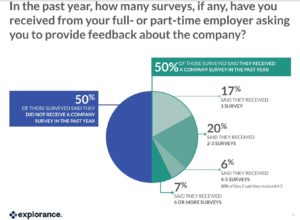In today’s world of work, it is common for companies to have mentorship programs. Approximately 70% of Fortune 500 companies have mentor programs while around 25% of smaller companies do. Although these programs are common, there is significant evidence that the majority of participants receive little benefit or engagement from them (Source).
The benefits of mentorship, done right, are endless:
-
Help employees feel valued and foster a greater sense of belonging. A lack of these two attributes are the top reasons why about 50% of people have left their jobs in the past year. (Source)
-
Aid in creating a sense of culture, connection and engagement during today’s remote work-from-home structure due to Covid-19.
-
Improve workplace diversity, equity and inclusion by increasing minority representation at the management level and improving promotion rates and retention rates among minorities and women. (Source)
-
Lower attrition costs. The cost of attrition ranges anywhere from half to two times the employee’s salary depending on the role. U.S. businesses are losing over a trillion dollars every year to voluntary turnover. A study conducted by Gartner and Capital Analytics at Sun Microsystems found much higher retention rates for mentees (72%) and mentors (69%) than other employees who did not participate in the mentoring program (49%). (Source)
-
Help build top talent within the company: almost 70% of organizations reported a boost in productivity as a result of mentoring programs. (Source)
-
83% of employees believe that companies should help with career progression, citing growth as a deciding factor in whether they stay or go. So does support for career growth, according to the majority (83%) of respondents who say their company should help with career progression. (Source)
With all these benefits, the question becomes: what do we need to do in order to make participants feel more engaged?
Here are the steps you can take to evaluate and refresh mentorship programs and avoid common issues that leave employees feeling alienated or uninterested:
-
Hit Refresh
-
Tackling “Mediocre” Mentors
-
Pairs with No Connection or Trust
Hit Refresh
Hitting the refresh button first requires organizations to understand their employees’ changing wants and needs. Maybe this is in the form of an anonymous satisfaction survey and/or focus groups and one-on-one conversations. The latter requires openness and honesty. If your organization does not currently have this environment, be honest, because your organization will need feedback from all levels and jobs functions – not only top performers or favorites among management. If there are no areas for improvement, chances are employees are not telling the whole truth; nothing is perfect. A holistic and balanced response is necessary for improvement.
Once feedback is solicited, communication to the workforce about how their feedback will be used to make meaningful changes is vital to ensure employees feel valued. First, sharing the feedback that the company receives is a move in the right direction and helps put everything on the table.
Almost 50% of employees and 40% of executives surveyed do not believe their feedback will lead to meaningful change. Of those employees that believe their feedback will not lead to meaningful change, a third (33%) are seeking new employment. (Source)
Management’s action, execution, and continuous communication will show employees how their feedback leads to meaningful change. Mentoring programs get stale quickly when the work culture lacks trust necessary where employees feel comfortable giving constructive feedback to higher-ups. The types of mentoring programs (1:1, mentor circles, reverse, diversity, and more) have evolved dramatically; so it is necessary to be open to new and creative ideas on what mentorship can look like. Better companies may have a mentoring program but best companies will create living programs that morph with market demands, company strategy and, most importantly, professional development needs of employees.
Tackling “Mediocre” Mentors
“Bad mentoring relationships are worse than no relationship at all […] negative interactions are much more salient than positive ones.” says Jean Rhodes, psychology professor at the University of Massachusetts, Boston. Poorly prepared mentors give mentorship and the organization a bad reputation. This can, “sabotage retention, commitment, and employee development — the very objectives that drive mentoring initiatives in the first place” (Source).
How organizations can get ahead of the curb:
-
Tweak the Selection Process:
-
Do not force or put pressure on everyone to become a mentor. It should be voluntary and if a more formal approach is desired, mentors should be hand selected and/or elected by their managers for displaying potential as a mentor.
-
If everyone is required, at a certain career stage to be a mentor, it quickly turns into a check-box item on a long list of to-do’s.
-
-
Provide Mentors with the Proper Resources
-
Mentorship is an intangible and abstract concept; therefore training can help provide success guidelines so mentors understand the objectives and the organization’s definition of success.
-
A good manager or rising star does not necessarily make a good mentor. When those who demonstrate promising qualities are given the proper training and guidance, they are more likely to be successful in this role.
-
There is strong evidence that the following skills can be “instilled and refined through mentor development training: generous listening, affirmation, challenge, feedback and insider information, networking, visibility, intentional role-modeling, professional socialization, advocacy, and increasing mutuality and collegiality” (Source).
-
In 2018, the Bureau of Labor Statistics found that companies with fewer than 100 employees gave their workers only 12 minutes of training from their manager every six months, and in organizations of 100 to 500 employees, that halved to six minutes. An Accenture study found that only about a fifth of employees said they received on-the-job training from their employer in five years. (Source)
-
When a mentor is not prepared for the role, mentees can typically pick up on it which can lead a mentee to feel disappointed and frustrated.
-
-
Reward and Recognize Contribution
-
When no meaningful incentives are attached to the mentor role, it is understandably seen as an arduous extra duty, a thankless distraction from real work which leads to the desired pay increase and advancement. (Source)
-
If recognition (physiological) and reward (monetary/physical) are not built into the structure of the program, oftentimes, mentors either lose steam in these “extra-curricular programs” or it never existed in the first place.
-
Pairs with No Connection or Trust
Pairing an employee with the “right” mentor is the most difficult part of mentoring and simultaneously the one we know least about according to Tammy Allen, author of Designing Workplace Mentor Programs. Some organizations use an algorithm-based system, some go completely random and others require mentees/mentors to find their own counterpart. Regardless of where your program may fall on the spectrum, the most effective programs give participants some level of input into the pairing decision. (Source)
Once a pairing is made, it is vital that the mentor takes the lead in creating an environment of trust. A qualitative study found that mentees have greater trust for those who are professionally competent, consistent, strong communication, show interest and a willingness to share control. In a further study, mentees attributed “being listened to”, “knowing the conversation was confidential”, and “not feeling judged” to how mentors can build more trusted relationships. These attributes helped create an honest and open environment (Source). Lack of trust has the unintended consequence of creating a disenfranchised workforce where low morale and high attrition prevail.
If mentor and/or mentee do not feel as though the relationship is improving, normalize mixing the pair and creating a new match. This can be done through regular pulse checks. The following questions are sample questions that can help ensure the program is creating the intended effect of employee engagement and development.
-
How well is the mentoring relationship working?
-
Do you (mentor/mentee) feel well-matched?
-
Is the experience positive, engaging?
If a bad match goes unnoticed and therefore forced to stay together, both parties are likely going to feel like they are checking boxes on a list of superficial “to do’s” and honest communication does not occur. This leaves mentees alienated and potentially on the search for an opportunity that gives them what they want and need. (Source)
Mentorship programs need to be thoughtful and supportive to help develop and retain talent. Mentoring impacts companies’ bottom line and if done right, ensures employees feel committed to accomplishing their work, engaged in the organization, and supported in their professional development journey.
In Conclusion
As the world is in its third year of the Pandemic and we are in the midst of The Great Resignation, now is the time for employers to seriously review their mentorship programs and quickly take action. Organizations must make the necessary changes to foster deeper professional connections or suffer greater consequences with low engagement and voluntary turnover.
Sources:
https://hbr.org/2021/05/what-great-mentorship-looks-like-in-a-hybrid-workplace
https://hbr.org/2020/07/why-your-mentorship-program-isnt-working
https://www.govexec.com/management/2022/01/how-mentor-young-workers-remote-world/360765/
https://www.guider-ai.com/blog/mentoring-statistics-the-research-you-need-to-know
https://www.benefitnews.com/news/mentorship-may-save-your-company-in-the-great-resignation
https://www.psafinancial.com/2018/03/most-fortune-500-companies-have-mentor-programs-do-you/







